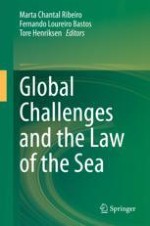2020 | OriginalPaper | Chapter
20. The European Union and the Future International Legally Binding Instrument on Marine Biodiversity Beyond National Jurisdiction
Author : Pascale Ricard
Published in: Global Challenges and the Law of the Sea
Publisher: Springer International Publishing
Activate our intelligent search to find suitable subject content or patents.
Select sections of text to find matching patents with Artificial Intelligence. powered by
Select sections of text to find additional relevant content using AI-assisted search. powered by
